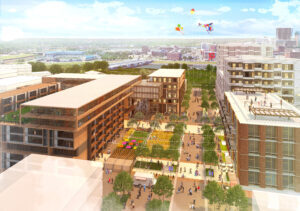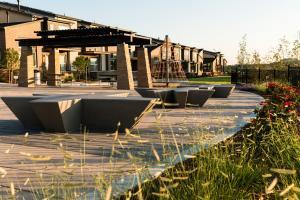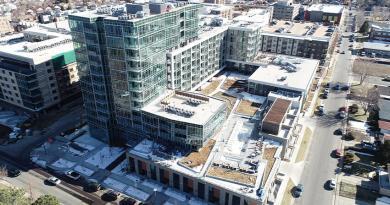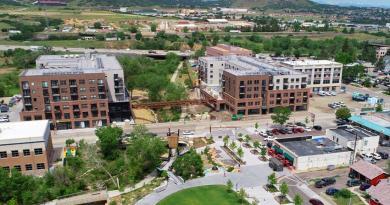The lay-of-the-urban-landscape
by Paul Suter
According to data from The World Bank, more than 55 percent of the world’s population lives in urban areas as of 2018 (up from 51 percent in 2010), and according to ScienceDirect, the urban population has increased from about 750 million in 1951 to 4.2 billion in 2018. And while urban locales across the Front Range and throughout Colorado obviously aren’t realizing an influx of millions of people, the population growth has been staggering.
The state’s population has grown from 5 million people in 2010 to 5.9 million people in 2020, and World Population Review shows some estimates putting Colorado’s population as high as 7.8 million people by 2040.
This population growth is certainly bringing more people into urban cores, and demanding foresight and creativity by urban landscape design professionals to address how theirwork can address the complexities of urbanization. The challenges extend far beyond designing appealing landscapes, but also touch heavily on spatial, ecological, economic, social and cultural aspects.
Some of Colorado’s finest urban landscape design experts shared their thoughts on what is important now and what must be part of the “built environment’s” critical thinking in the years to come.
A “15 Minute City” has become a design goal, in part due to the pandemic, where it became evident that people living in an urban environment should have easy access to parks, healthy outdoor spaces, fresh air and the things that promote and sustain a healthy lifestyle.
Craig Karn, principal and founder of Consilium Design, puts water at the top of his list in-regards-to what will drive how things are done now and into the future. He is working on creating resilient and regenerative landscapes based on Total Hydrology Planning that examines how to best take advantage of all water resources (including storm water, gray water and even condensation from air conditioning units). Consilium’s approaches include capturing water in parking lots with bioswales, inverted designs (so water drains into landscapes) and managing the urban heat island effect with an abundance of tree canopies comprised of drought-tolerant trees such as Catalpas, Hackberry trees and
Honey Locusts.
As multifamily projects continue to rise in cities, to accommodate the population growth, Denver’s Green Building Ordinance is turning rooftops into environmentally productive landscapes with gardens, planters and plaza settings. Denver’s “dog crazy” residents are also driving the opportunity to create rooftop dog parks with synthetic surfaces and drainage systems. According to Mr. Karn, urban landscapes will have to be more tolerant of the human condition and design professionals will have to rethink the expectations of aesthetics. For example, it’s impossible to transplant a Midwest landscape to the desert climate of Colorado. People must accept fundamentally different landscapes that aren’t just visually pleasing, but contribute to water conservation and management, air quality and overall sustainability.

Bill Mahar, a principal at Norris Design, stresses an understanding of local municipalities and proactive community outreach. Creating inclusive communities of diversity and equity is an important part of the urban landscape design profession, and by finding partners within a community, a strong foundation can be put into place and the unique needs of a neighborhood can be addressed during the design process.
Projects must be right-sized to fit the context and comfort level of a community while serving a wide range of desires. For example, shared amenities and common spaces, such as parks and playgrounds and community gardens, can provide valuable urban landscapes to people living in urban environments.
As a result of the pandemic, leaders understand how critical open space is for a person’s physical and mental health, giving outdoor spaces a new prominence in urban design. This renewed focus is leading the way to more creative outdoor spaces including pollinator gardens, playgrounds that do more than just provide playground equipment but also include teachable design ideas and community gardens. Likewise, sports and recreation centers are being designed with more than just playing fields in mind. They are including amenities such as skate parks, mountain bike courses, climbing walls and pickleball courts.
Mr. Mahar also stresses how important water continues to be to development in the west. This most critical resource strongly influences what landscapes look like, based on factors such as tap fees and irrigation. Creative design ideas must meet the needs of low water landscapes.
Greg Dorolek, principal at Wenk Associates, has a keen eye for ways to maximize open space and parks in an urban setting, all of which will need to be more creatively assembled and considered during the design process. Planning parks and open space for where people are not, opposed to where they are will help to transform concrete cityscapes into spaces that help to better define a neighborhood and encourage people to engage with the outdoors. The Art Park in River North is one example of a newly created park that is much more than grassy ballfields. It provides people in the area with a community center, a branch of the Denver Public Library, a space for the Comal Heritage Food Incubator and an art gallery.

Another example of maximizing open space is the River Mile project, where floodplains will be restored, natural habitats will be preserved and people will have more accessibility to the South Platte River. Considering the natural environment as an asset helps to create a green infrastructure that brings sustainability, urban nature and richness to a site. Wenk is also working on the Loretto Heights project and discovering creative ways to repurpose the 100-acre campus and create landscapes that support the green infrastructure and contributes to the surrounding community as a whole.
Mark Johnson and Chris Parezo of Civitas are also taking deep-dives into the complexities and challenges associated with urban landscape design. Finding ways to “stitch-together” urban neighborhoods is high on the list of priorities and is being accomplished by reimaging the public realm to prioritize placemaking, health and human scale mobility. This is being accomplished through the 5280 Trail completed with the Downtown Denver Partnership and The Haven Project in South Bronx. Green connections are also threading their way through cities by repurposing streets, railroad tracks, and parkways to increase public greenspace. For example, repurposing plans for Hale Parkway in Denver are underway to turn the thoroughfare into more of a greenbelt. Rather than digging-up the pavement to lay down pipes to control flooding, the parkway will become the infrastructure with natural vegetation and open streams.
As part of the Van Allen Institute, Mr. Johnson is helping to promote the importance of integrating citizens into the design and development process. Rather than having developers set-the-vision for a community, the people who live and work there should be highly involved in writing the script for development in their neighborhoods. This approach will help to ensure that ideas are being introduced that will satisfy the overall needs of the community while contributing to positive transformations.

Phil Steinhauer, owner of Designscapes Colorado, is actively working with municipalities to improve and revive parks, open spaces and even the playgrounds and playing fields at elementary schools. A great deal of the work involves the reuse of materials, including boulders downed trees and flood debris that can be converted into use on organic playgrounds. Reduced lawns, interactive trails, pathways and urban gardens are all the more prevalent in the revival and renovation efforts.
Multifamily projects are also making a push to the outdoors, where more and more outdoor spaces are being created. These areas include larger patios, entertainment areas and common outdoor spaces. On the ground level, the landscapes are being elevated with more drought-tolerant native grasses as property owners and cities work to beautify their urban corridors.
Jim MacRae, principal at Design Workshop, reflects on the affects the pandemic has had on public landscapes, especially as it relates to the growing need for outdoor spaces in urban environments. Streetscapes, alleyways and park are now faced with a more critical eye as thought leaders discover ways to convert these urban amenities into more pedestrian and user-friendly spots to rest, recreate and socialize. For example, streets that were closed to accommodate outdoor dining during the pandemic may remain closed, and even dressed-up more with attractive features and activities. Alleyways may become places where people can gather for drinks, food and fun, opposed to being service corridors for trash pick-up and deliveries.
As more people move into the urban core, the infusion of capital and activity will make cities a 24-hour/7-day-a-week center of attention. Pocket parks, small concert stages and tactical urban amenities will raise the level of enjoyment and attractions that a city can provide. By minimizing vehicular traffic and dedicating roadways to bike zones and pedestrian walkways, cities will become a safer and more pleasant place to be.




